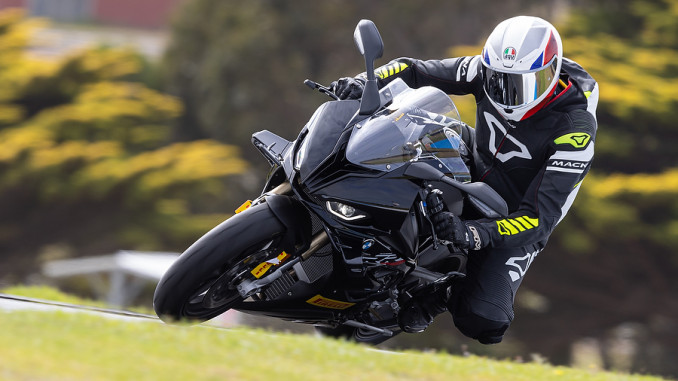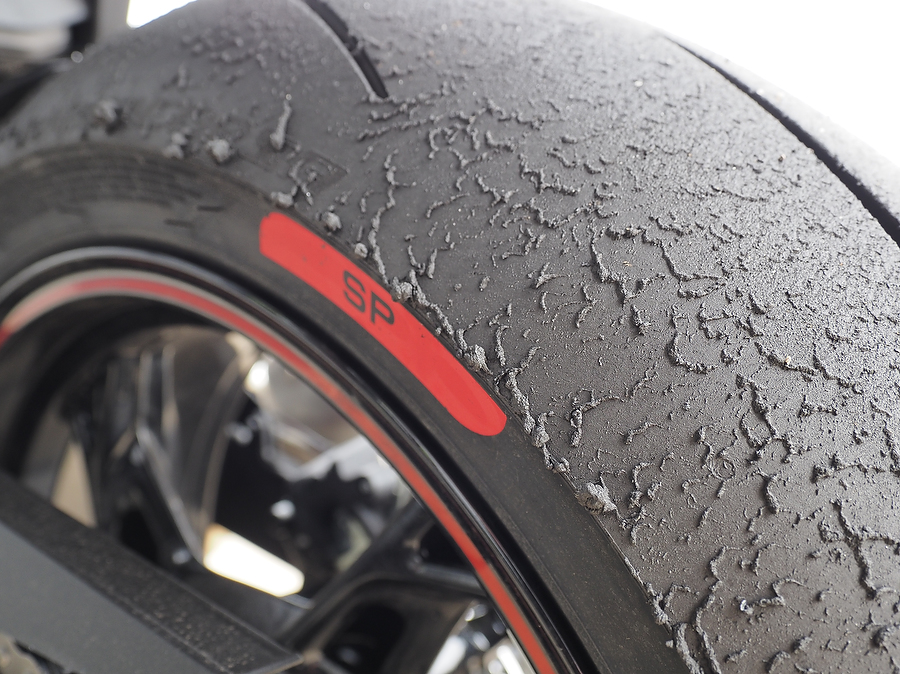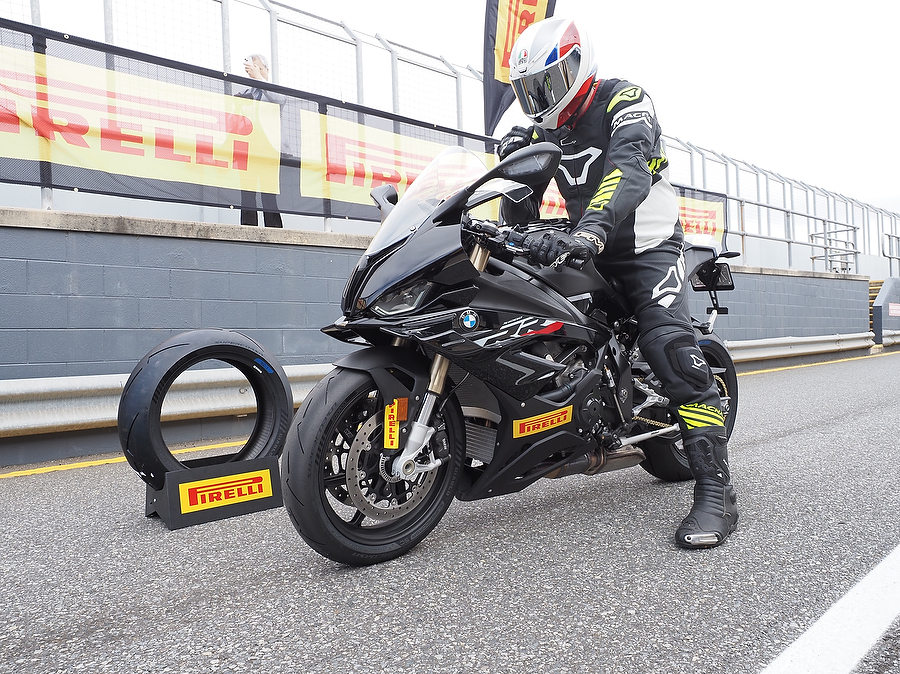
PIRELLI DIABLO SUPERCORSA V4 LAUNCH
Pirelli gets closer to offering street-suitable race tyres…
BY NIGEL PATERSON
As I wound the throttle on over the crest of the hill with the bike still leaned over, the rear tyre started to slide, breaking traction as its ability to hang on was overpowered by the powerful four-cylinder sportsbike. My heart rate was probably shooting up as I backed off slightly, wanting to regain traction without aggressively trying to stop the slide… heart-in-mouth stuff.
That experience was a couple of decades ago, at Oran Park riding a Suzuki GSX-R1100. No traction control, early-generation radial tyres, the very real chance of a high-side crash if the slide had gone too far.
After that experience, I nearly high-sided a Honda CBR900RR at Phillip Island, getting thrown up in the seat but luckily landing back in it and getting the bike under control. There were also numerous “moments” at Eastern Creek (now Sydney Motorsport Park) and the big one, a high-side crash on an R6 at Phillip Island, in the late ’90s. Not much carnage for 30 years of ride days, bike launches and photo shoots.
So I came to Phillip Island for the launch of the new Pirelli Diablo Supercorsa V4, where I would be riding the 2023 BMW S 1000 RR, with some trepidation — the first time I’d ridden on a track in two years and the first time on an open-class sportsbike since 2015.
I’m very happy to report any nervousness was gone before the end of my first track session, and by the third I was cracking the throttle of the 200+hp S 1000 RR hard out of slow turns and rocketing between corners, trusting the electronics to tamp-down any unreasonable enthusiasm as I tried to test the adhesion limits of the tyre and electronics of the fast BMW.
Modern tyres and bikes are incredible — much, much safer to ride fast than older generations.
Cracking the throttle open hard while still leaned over made the SP version of the Diablo Supercorsa squirm around in a way that made me feel fast, even if my lap times could be recorded with a sundial. Phillip Island’s turns 10-11-12 leading onto the straight are legendary, turns which dictate your top speed down the straight. By the time I was riding under the big “Melbourne” sign and tipped over from going uphill to downhill (Phillip Island’s Gardner straight is not flat, although it looks that way on television), I was a bit too busy to be checking my speed… vastly more interested in getting the approach to the fast Doohan Corner right. I never did get it right, but that’s OK — I didn’t cock it up significantly either, so I’m happy with that.
The new Supercorsas are available in numerous models; from the road-biased “race replica” SP model to the race-focussed SC1, the fourth-generation Diablos cover a wide range of bikes, rider abilities and needs.
NEW GENERATION
For the latest generation of its supersport rubber, Pirelli had a target of “striking control even when pushing hard”. To achieve this target, the new tyres feature a mix of carbon black and silica compounds with thicker structural textile cords and increased structural stiffness, all offering enhanced damping characteristics.
The tread pattern has been updated too, with a “flash”-shaped groove that we’re told offers better water dispersion and more consistent wear. The land/sea ratio, used to describe the percentage of rubber to grooves, is down to 4.1 per cent, so these tyres are getting close to being street-legal slicks.
FOR THE ROAD RIDER — SP
Pirelli claims the Diablo Supercorsa SP V4 is “a pure race replica experience”, essentially offering racing-compound slick edges while still being suitable for street use, even if you’re caught in some rain.
During the launch, Pirelli told us the new V4 tyre is better in every respect than the V3, in particular regarding grip and racetrack consistency. Using a group of riders for testing purposes at the Racalmuto circuit, a short 2.5km track with nine turns, lap times came down, lean angles increased, full throttle was used more and G-forces increased. The company’s engineers have achieved this with first multi-compound front Diablo Supercorsa V4 with this fourth-generation tyre. Unlike conventional dual-compound tyres, the Diablo Supercorsa V4 front features a central and base layer that is harder, with a full silica compound, for durability and wet-weather performance.
The base layer runs right across the width of the tyre — in the centre it’s higher, being also the contact path. The shoulder/edge compound is 100 per cent carbon black, the same compound as the SC3 track tyre, for extreme grip at high lean angles. This softer, sticker compound is bonded to the Silica base layer for thermal stability.
There’s no tread on the shoulders, so the tyre is effectively a slick when riding hard.
The SP’s rear is effectively three compounds: a 100 per cent carbon black base (the Adaptive Base Compound), SC3 side bands for extreme performance, and a slightly harder central compound for durability, wet-weather traction and stress-resistant high-speed stability.
The result is a tyre with excellent thermal stability, meaning it doesn’t require perfect temperatures to work well, copes well with thermal cycling (going from hot to cold and back again), lasts longer than any of the track-biased models, and works well across a wider range of tyre temperatures.
The SP isn’t recommended for track use, but with SC3 edges it certainly works and is the tyre to choose if you ride to the track before riding on the track.
I had one session on a S 1000 RR fitted with SPs and was able to feel the rear squirm as I pushed hard while cranked over, especially leading on to the straight. This excellent feel gave me the confidence to push hard and by the end of the session, the tyre was balling up nicely and feeling very, very sticky on the edges.
In contrast, the front was kinda laughing at my ability… and it’s a characteristic of the Phillip Island track being such a flowing design. Gumbies like me don’t actually push the front very hard.
If you’re looking for a tyre you’re going to primarily use on the street, the Supercorsa SP is definitely the go. For owners of premium sportsbikes who push hard, Pirelli has built this tyre for you and your bike. It’ll cope with a ride day or track training day no problem, but if you’re looking for something more suited to track riding and don’t ride to the track, the SC models are better.
TRACK MODELS
Developed from the racing slicks, the Diablos were born as a treaded tyre for Supersport and Superstock categories that required treaded tyres — and the SC1 and SC2 models of the Supercorsa V4 are the latest models. If you’re going racing or ride at racing speeds at ride days, the super-sticky SC1 or more durable SC2 are the Diablos for you.
These “Special Compound” models feature a high content of carbon black for incredible dry-weather grip. They are built to cope with the heat characteristics of track use, where ultra-high speeds are often followed by extreme braking and lean angles. The carcass is designed to cope with the extreme pressures pushed into the tyre and still maintain an appropriate contact patch, and edge grip is incredible for driving hard out of corners.
Where the SC1 is designed for smoother surface, more abrasive tracks are better suited to the SC2, a tyre which provides better racing stability and consistency of wear, and it’s less sensitive to low tyre temperatures, so is a better choice for times when conditions aren’t great.
Using an SC1 front and SC2 rear has become common, especially for endurance racing — although the SC3 will give longer tyre life. The better lap times of the SC2 can more than make up for the extra time lost in the pits with extra tyre changes.
But we’re still talking racing here, serious, fast and hard-on-tyres performance. The SC3, originally developed with endurance racing in mind, has become the tyre of choice for ride-day punters. Built to provide heaps of grip and feel with resistance to heat cycling and good longevity, the SC3 is Pirelli’s affordable track tyre because it warms up quickly, even without tyre warmers. Tyre life is considerably longer than SC1 or SC2, and grip levels are so high if you’re not doing race lap times that there’s a good chance you won’t be getting the full benefit out of the stickier rubber.
SIZES & PRICES
Pirelli is making the Diablo Supercorsa V4 SP in sizes to suit modern sportsbikes, from small to large capacities, all in 17-inch and all are ZR rated.
For the smaller bikes there will be a 110/70 coming in June to join the 120/70 already available. There are eight rear sizes available or coming over the next few months, in widths from 140 to 200 and a variety of profiles.
The SC models will be available in a range of sizes to suit most modern track bikes, with 110- and 120-wide fronts and 120- to 200-wide rears in a variety of SC1, SC2 and SC3 compounds.
Prices for the SP model (RRP) run from $299.95-$339.95 (fronts) and $349.95-$499.95 (rear). SC models are in a similar range – $299.95 to $529.95 depending on size and compound.
THE DIABLO RANGE
Pirelli now has five different ranges of its sporty Diablo tyres, each with different characteristics and designed for different purposes.
The stickiest is the Diablo Superbike — track-only slicks with extreme dry-weather performance and no wet-weather use recommended at all! From a mileage point of view they don’t last very long, although they are rated at a similar life to the Supercorsa SC range… within that the SC3 lasts longer than an SC2 which lasts longer than an SC1… but we’re still talking track tyres.
The road-suitable Supercorsa SP should last at least 50 per cent longer than an SC3, although for 100 per cent track riding you wouldn’t buy the SP, you’d buy an SC.
The Diablo Rosso IV is more road biased. It offers around 80 per cent of the dry-weather performance of the Supercorsa SP but triple the wet-weather performance and nearly double the tyre life.
The Diablo IV, which Pirelli describe as “The Sporty Tyre for the Road”, sees a small drop-off in dry-weather performance compared to the Rosso IV, but even better wet-weather traction — and a significant jump in mileage.







